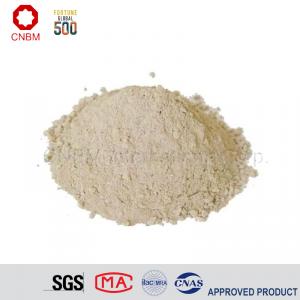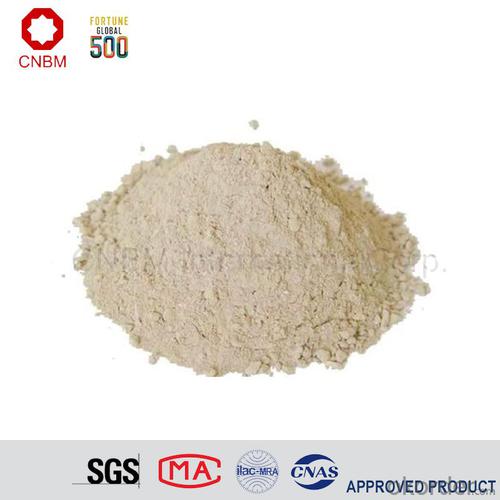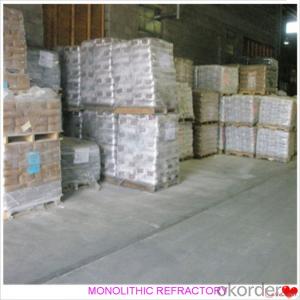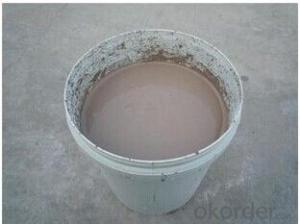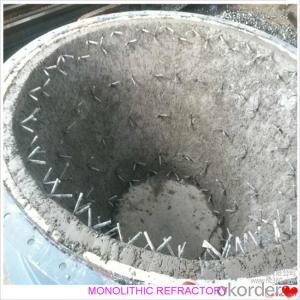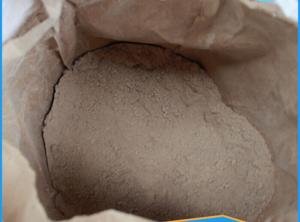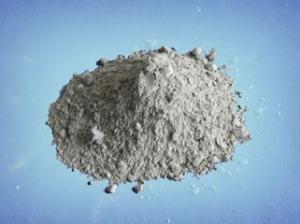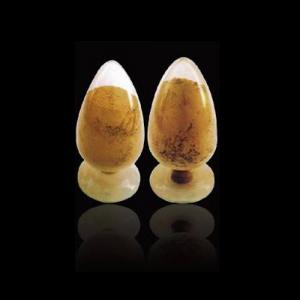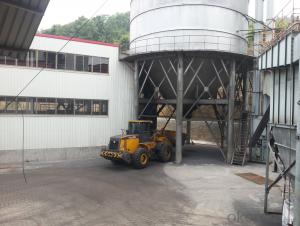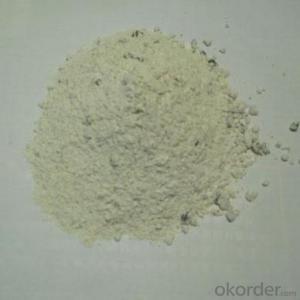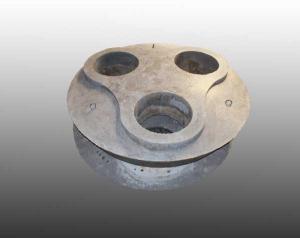Monolithic High Temperature Castable Refractory Cement for Iron and Steel Industry
- Loading Port:
- Dalian
- Payment Terms:
- TT or LC
- Min Order Qty:
- 23 m.t.
- Supply Capability:
- 60000 m.t./month
OKorder Service Pledge
OKorder Financial Service
You Might Also Like
Refractory Plants
Our plant is one of the research institutes on refractory materials in CNBM. It was set up in 2001. Taking the advantages of combining research,process,marketing and technical service,CNBM supply not only first-class refractory materials but also supply distinctive technical services.
·17 plants in different cities.
·Annual output is 5000,000 tons per year.
·ISO 9001:2008 certificated
·The products cover the refractory area of steel-making, cement, non-ferrous, glass, ceramic and others.
Physical And Chemical Indicators For Castable
| Brand Properties | HCA-180 | HCA-170 | HCA-160 | HCA-150 | HCA-140 | |
| ºC Application Limit Temp | 1,800 | 1,700 | 1,600 | 1,500 | 1,400 | |
Bulk Density (g/cm3) | 2.95 | 2.45 | 2.30 | 2.15 | 2.10 | |
| (%)Water Required for Casting | 8-11 | 10-14 | 10-14 | 11-15 | 11-15 | |
CCS/MOR (MPa) | at110ºCx24h | 60(10) | 45(8.5) | 40(8) | 40(8) | 35(6) |
| at1,200ºCx3h | 55(9.5) | 50(9) | 45(8.5) | 50(9) | 40(8) | |
| at1,400ºCx3h | 80(15) | 55(10) | 50(9) | 55(9.5) | 45(8.5) at1,300ºC | |
| (%) Permanent Linear Change | at110ºCx24h | -0.03 | -0.06 | -0.06 | -0.06 | -0.06 |
| at1,200ºCx3h | -0.1 | -0.2 | -0.2 | -0.15 | -0.15 | |
| at1,400ºCx3h | +0.4 | -0.3 | -0.2 | -0.3 | -0.4 at 1,300ºC | |
| (%) Chemical Analysis | Al203 | 91 | 76 | 63 | 52 | 48 |
| SiO2 | 1.5 | 15 | 27 | 40 | 44 | |
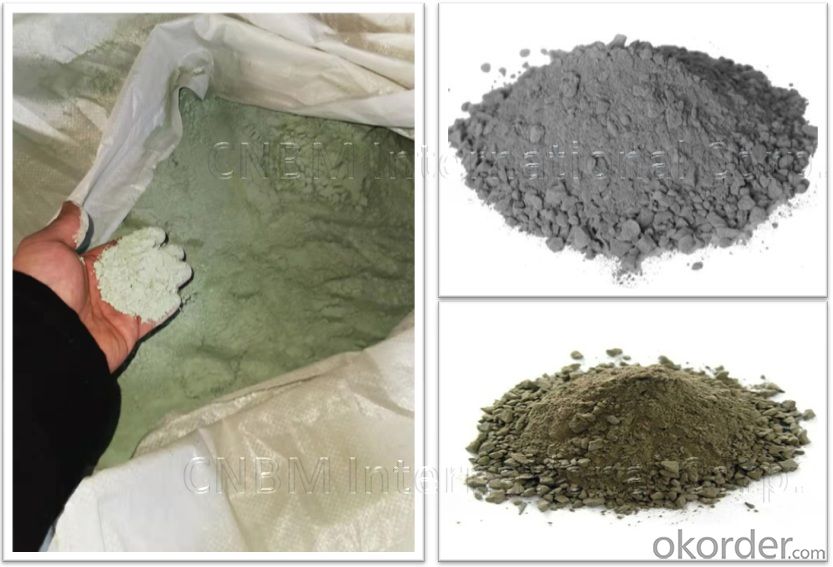
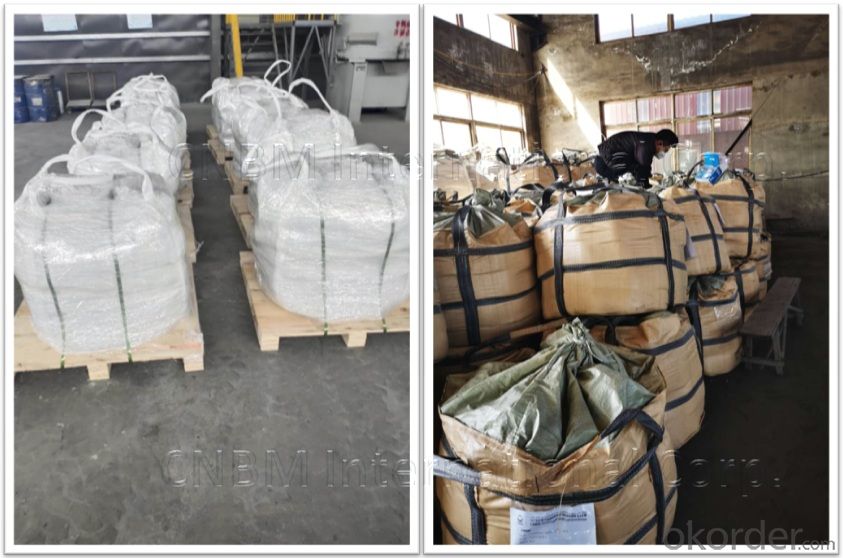
Features Of Castable
High refractoriness, High refractoriness under load
High density, low porosity
Good slag resistance and corrosion resistance
High strength and wear resistance
Good resistance to flake performance
Good thermal shock stability
Scouring resistance
Good hot strength.
Applications Of Castable
Nonferrous Metal Furnace
Various Incinerator
Reheating Furnace
EAF, Ladle, Tundish, etc.
Specifications Of Castable
It is widely used in key area of linings in metallurgical industry, petrochemical industry, power plant, construction field and other industries. Especially for the areas where easily worn and broken
Company Profile
CNBM INTERNATIONAL CORPORATION
Build your world with our materials.
We are a primary subsidiary of China National Building Material Group Co., Ltd.
CNBM Group is a central government-owned enterprise and a Fortune Global 500 company (Ranking 203th in 2019). It is the largest building material manufacturer and service provider in the world, with 15 publicly-listed companies and over 180,000 employees (2019). We have more than 300 factory plants in China. For the refractory, we are top 3 in China. We have more than 17 plants in different cities.
Proprietary Technology & Patented Products
Refractory technology
All process are conform to ISO9001 quality control systems
(1)The test of raw materials
★For all raw materials, the purchase department give the test report to the quality supervision department.
(2)The control of production
★Each batch products will be tested
★The quality supervision department record all test result.
(3)Test Before Production
★Before packing, the quality supervision department test the chemical content and physical
★Only quality products can be delivery.
★The delivery department check the package, quantity, name, code, production date, etc.
(4)Quality Traceability Analysis
★Track the products after using and get the feedback of performance.
If customer required, we will give the customer technical solutions and also improve the products.
Damage Mechanism Analysis and Improvement
★ For the maintenance project, CNBM will check the damage condition of the refractory materials in the furnace carefully.
★And then CNBM will give the damage mechanism analysis report to the customer.And CNBM also will provide products improvement solutions to extend the products' service life.
Technical Solution& Construction
★Optimization solutions of the original design to the customer.
★Consultation Service of Refractories Technology
★Technical Staff Training in Refractories Technology
★Specialized Design and Refractories Selection
FAQ
Q:Are you a trading company or manufacturer?
A:CNBM is a large-scale central governmental industrial group with its own manufacturing sector, research and development sector, trading sector and logistics sector.
Q:I have some special requirement about specifications.
A:We have a well-rounded product range, which endows us with the capability of applying many special specifications. Please feel free to contact us with yours.
Q:Do you accept OEM service?
A:Yes, we do.
Q:What is your delivery time?
A:It depends on the size/complexity of your order and our own production schedule. Usually we provide a faster delivery than the industry's average.
Q:What is the payment term?
A:Our payment terms are negotiable.
Q:Can I have my own logo on the product?
A:Sure, we can apply your own logo on the products according to your drawings.
- Q: What are the challenges faced in the application of monolithic refractories?
- Some challenges faced in the application of monolithic refractories include proper material selection, achieving proper installation techniques, ensuring consistent and uniform application, controlling drying and curing processes, and dealing with potential shrinkage and cracking issues. Additionally, monolithic refractories often require skilled labor for installation and maintenance, and they may be susceptible to erosion, thermal shock, and chemical attack in certain environments.
- Q: How do monolithic refractories improve the efficiency of ladle and tundish preheating stations?
- Monolithic refractories play a crucial role in enhancing the efficiency of ladle and tundish preheating stations. These refractories are specifically designed to withstand high temperatures and thermal shocks, making them ideal for use in preheating applications. One key way in which monolithic refractories improve efficiency is by providing excellent heat insulation. These refractories have low thermal conductivity, meaning they minimize heat loss from the preheating station to the surroundings. As a result, more heat is retained within the ladle or tundish preheating station, leading to faster and more efficient heating of the vessel. Additionally, monolithic refractories offer superior heat retention properties. Once heated, these refractories have the ability to store and release heat gradually over time. This characteristic allows for a more consistent and controlled heating process in the ladle or tundish preheating station. By maintaining a stable temperature, the refractories ensure that the vessel is heated uniformly and prevent thermal shocks that could lead to cracking or other damage. Furthermore, monolithic refractories have excellent resistance to chemical reactions and erosion caused by molten metals and slag. Ladles and tundishes are often exposed to corrosive environments, and the use of monolithic refractories helps to protect against degradation and extend the lifespan of the preheating station. This durability reduces the need for frequent maintenance and replacement, leading to cost savings and improved overall efficiency. In summary, monolithic refractories improve the efficiency of ladle and tundish preheating stations by providing excellent heat insulation, heat retention, and resistance to chemical reactions. These properties result in faster and more uniform heating, reduced heat loss, and increased durability of the preheating station. Ultimately, these benefits contribute to improved productivity and cost-effectiveness in the steelmaking process.
- Q: How do monolithic refractories withstand mechanical stress in the iron and steel industry?
- Monolithic refractories are designed to endure mechanical stress in the iron and steel industry due to their distinctive composition and properties. Unlike traditional brick-like refractories, which consist of multiple pieces, these refractories have a single, uniform structure. This monolithic structure offers several advantages in terms of mechanical stress resistance. To begin with, monolithic refractories possess greater strength and density compared to traditional refractories. This enables them to withstand the mechanical forces exerted during various processes in the iron and steel industry, such as the movement of molten metal, the impact of scrap materials, or the pressure from gases and liquids. Their superior strength and density help prevent cracking, deformation, or failure under these stressful conditions. Moreover, monolithic refractories provide excellent resistance to thermal shock, which is crucial in the iron and steel industry. The rapid heating and cooling cycles experienced in processes like steelmaking or iron casting can subject refractories to thermal stress. However, the monolithic structure of these refractories allows for better thermal conductivity and expansion, reducing the risk of thermal shock damage. This ability to withstand thermal stress contributes to their overall resistance to mechanical stress. Furthermore, monolithic refractories can be customized and applied on-site, resulting in a seamless lining that eliminates joints or weak spots. This seamless application ensures a more uniform distribution of stress and prevents the formation of cracks or gaps that could weaken the refractory lining. By eliminating these vulnerabilities, monolithic refractories enhance their ability to resist mechanical stress in the demanding conditions of the iron and steel industry. In conclusion, monolithic refractories endure mechanical stress in the iron and steel industry due to their high strength and density, superior resistance to thermal shock, and seamless application. These properties enable them to withstand the intense mechanical forces encountered during various processes, ensuring the durability and efficiency of refractory linings in this demanding industry.
- Q: How are monolithic refractories installed and repaired in iron and steel applications?
- Monolithic refractories are installed and repaired in iron and steel applications using specific procedures to ensure optimal performance and longevity. The installation process typically involves the following steps: 1. Surface preparation: The surface where the monolithic refractory will be installed needs to be properly cleaned and prepared. This includes removing any loose material, dirt, and dust. It is crucial to have a smooth and clean substrate to ensure good adherence of the refractory material. 2. Mixing the refractory material: Monolithic refractories are typically supplied as dry powders or granules that need to be mixed with water or a specific bonding agent to form a workable consistency. The mixing process should be done according to the manufacturer's instructions to achieve the desired properties of the refractory. 3. Application: The mixed refractory material is then applied to the prepared surface using various techniques such as troweling, spraying, or casting. The choice of application method depends on the specific requirements of the installation and the type of monolithic refractory being used. 4. Curing: After the refractory material is applied, it needs to be properly cured to achieve its maximum strength and durability. Curing can be done by air drying, using heat, or a combination of both, depending on the specific refractory material being used. The curing process should be carried out gradually and according to the manufacturer's recommendations. When it comes to repairs of monolithic refractories in iron and steel applications, the following steps are generally followed: 1. Assessment: The damaged area or component needs to be thoroughly assessed to determine the extent of the damage and the appropriate repair method. 2. Removal of damaged material: The damaged monolithic refractory material is carefully removed using appropriate tools and techniques. It is important to remove all the damaged material while ensuring that the underlying substrate is not further compromised. 3. Surface preparation: Similar to the installation process, the surface where the repair will be carried out needs to be properly cleaned and prepared. Any loose material, dirt, and dust should be removed to create a clean and smooth substrate. 4. Application of repair material: The repair material, which is typically the same or similar to the original monolithic refractory, is mixed and applied to the damaged area. The application method may vary depending on the nature of the repair and the specific requirements of the refractory material. 5. Curing and post-repair inspection: The repaired area should be properly cured and inspected to ensure the quality and effectiveness of the repair. Curing and inspection procedures should adhere to the manufacturer's guidelines. In summary, the installation and repair of monolithic refractories in iron and steel applications require careful surface preparation, proper mixing and application of the refractory material, and appropriate curing procedures. Following these steps in a meticulous manner ensures reliable and durable refractory linings, which are essential for the efficient operation of iron and steel processes.
- Q: How are monolithic refractories different from traditional refractory bricks?
- Monolithic refractories, unlike traditional refractory bricks, are composed of a single, homogeneous structure. This structural distinction leads to several differences between the two. Firstly, monolithic refractories provide greater flexibility and versatility in terms of shape and installation. They can be easily molded and shaped to fit specific applications and complex geometries, making them ideal for lining furnaces, kilns, and other high-temperature equipment. Secondly, monolithic refractories have superior thermal shock resistance compared to traditional refractory bricks. Their uniform structure allows for better heat distribution, minimizing the risk of thermal stress and cracking. This makes them suitable for applications with rapid temperature fluctuations or severe thermal cycling. Additionally, monolithic refractories often exhibit better overall performance in terms of strength, mechanical properties, and resistance to chemical attack. The absence of joints and seams eliminates potential weak points, resulting in a more durable and reliable lining. Moreover, the homogeneous structure provides better resistance to corrosive agents, ensuring prolonged service life in harsh environments. Lastly, monolithic refractories offer advantages in terms of installation and maintenance. Their monolithic nature simplifies the installation process, reducing labor and time requirements. Additionally, repairs and maintenance can be carried out more easily and cost-effectively compared to traditional refractory bricks, which may require the replacement of entire sections or bricks. In summary, monolithic refractories differ from traditional refractory bricks in structure, flexibility, thermal shock resistance, performance, and installation characteristics. These differences make monolithic refractories a preferred choice in many high-temperature applications, offering improved efficiency, durability, and ease of use.
- Q: How do monolithic refractories enhance the performance of ladle and tundish purging systems?
- Monolithic refractories play a crucial role in enhancing the performance of ladle and tundish purging systems in several ways. Firstly, monolithic refractories offer excellent thermal insulation properties. Ladle and tundish purging systems require high temperatures to effectively remove impurities and gases from molten metal. The use of monolithic refractories helps to minimize heat loss and maintain the desired temperature within the system. This ensures that the purging process is carried out efficiently and effectively. Secondly, monolithic refractories provide superior erosion and corrosion resistance. During the purging process, the molten metal and purging gases can be highly corrosive and abrasive. Monolithic refractories are designed to withstand such harsh conditions, preventing erosion and corrosion of the lining. This prolongs the lifespan of the ladle and tundish purging systems, reducing the need for frequent repairs or replacements. Furthermore, monolithic refractories offer excellent strength and stability. Ladle and tundish purging systems experience significant mechanical stresses due to the movement of molten metal and purging gases. The use of monolithic refractories ensures the structural integrity of the lining, preventing any deformation or failure under these conditions. This allows for smooth and uninterrupted purging operations, improving the overall performance of the system. In addition, monolithic refractories provide ease of installation and maintenance. Unlike traditional brick and mortar refractories, monolithic refractories can be easily applied as a single, homogeneous layer. This simplifies the installation process and reduces the time and effort required for maintenance. Any necessary repairs or replacements can be carried out more efficiently, minimizing downtime and maximizing the productivity of the ladle and tundish purging systems. Overall, monolithic refractories enhance the performance of ladle and tundish purging systems by providing excellent thermal insulation, erosion and corrosion resistance, strength and stability, as well as ease of installation and maintenance. These properties contribute to the efficient and effective removal of impurities and gases from molten metal, ensuring high-quality output and optimizing the overall productivity of the purging process.
- Q: How do monolithic refractories prevent heat loss through radiation?
- High thermal conductivity and low thermal expansion are characteristics of monolithic refractories that prevent heat loss through radiation. These properties enable efficient heat transfer from the hot side to the cooler side, minimizing temperature differences and reducing radiation heat loss. Furthermore, monolithic refractories create a seamless and continuous lining that eliminates gaps and cracks, which would otherwise allow heat to escape. The dense and compact structure of these refractories functions as a barrier, preventing radiation heat transfer. In conclusion, monolithic refractories are essential for maintaining thermal insulation and preventing radiation-induced heat loss in a range of high-temperature applications.
- Q: How are monolithic refractories installed in iron and steel production processes?
- Monolithic refractories are installed in iron and steel production processes by first preparing the surface, then applying the refractory material in a plastic or semi-plastic state. This can be done through various methods such as gunning, casting, ramming, or spraying. After the installation, the refractory material is allowed to cure and harden, forming a durable lining that can withstand high temperatures and harsh conditions in the production processes.
- Q: What are the recommended storage and handling practices for monolithic refractories?
- The recommended storage and handling practices for monolithic refractories are crucial to ensure their optimal performance and longevity. Here are some key practices to follow: 1. Storage: Monolithic refractories should be stored in a clean, dry, and well-ventilated area. The storage facility should be protected from moisture, extreme temperatures, and direct exposure to sunlight. Ideally, the refractories should be stored on pallets or racks to prevent contact with the ground and minimize the risk of damage. 2. Handling: It is essential to handle monolithic refractories with care to avoid any physical damage. Refractories should be lifted and moved using appropriate lifting equipment, such as forklifts or cranes, to prevent excessive stress or strain on the material. Avoid dropping or dragging the refractories, as this can lead to cracks or fractures. 3. Packaging: If the monolithic refractories are supplied in packaging, it is important to inspect the packaging for any signs of damage or moisture before accepting the delivery. Damaged packaging can indicate potential damage to the refractory material. If any anomalies are noticed, it is advisable to inform the supplier immediately. 4. Moisture control: Monolithic refractories are susceptible to moisture absorption, which can lead to reduced performance and structural integrity. It is crucial to protect the refractories from direct contact with water or excessive humidity during storage and handling. If refractories become wet, they should be dried thoroughly before use to eliminate any absorbed moisture. 5. Stack height: When storing monolithic refractories, it is important to consider the stack height. Excessive stacking can result in pressure on the lower layers, leading to deformation or cracking. Follow the manufacturer's recommendations for maximum stack height to ensure the refractories' structural integrity. 6. Regular inspection: Regularly inspect the refractory material for any signs of damage or degradation during storage and handling. Look for cracks, spalling, or any other visible abnormalities. If any issues are identified, consult the manufacturer or a refractory expert for guidance on whether the material is still suitable for use. By following these recommended storage and handling practices, you can minimize the risk of damage to monolithic refractories and optimize their performance, ultimately extending their service life and ensuring their effectiveness in high-temperature applications.
- Q: What are the typical properties of monolithic refractories used in iron and steel industry?
- Monolithic refractories used in the iron and steel industry typically possess high thermal conductivity, excellent resistance to thermal shock, and high mechanical strength. They are also known for their ability to withstand high temperatures and harsh chemical environments. Additionally, these refractories exhibit good erosion and abrasion resistance, low porosity, and high density, making them ideal for lining furnaces, ladles, and other equipment in the iron and steel production process.
Send your message to us
Monolithic High Temperature Castable Refractory Cement for Iron and Steel Industry
- Loading Port:
- Dalian
- Payment Terms:
- TT or LC
- Min Order Qty:
- 23 m.t.
- Supply Capability:
- 60000 m.t./month
OKorder Service Pledge
OKorder Financial Service
Similar products
Hot products
Hot Searches
Related keywords
